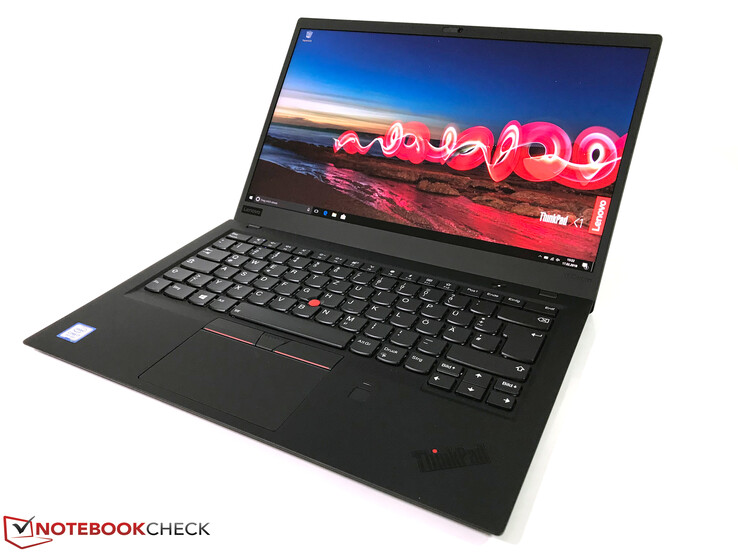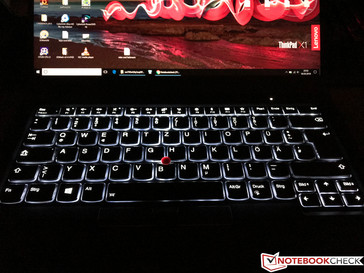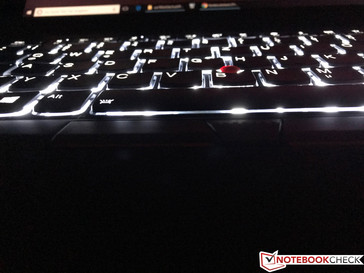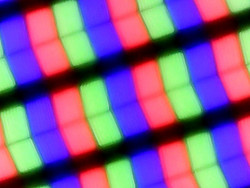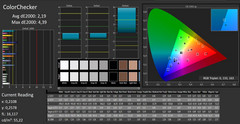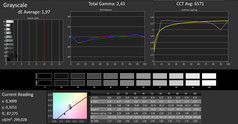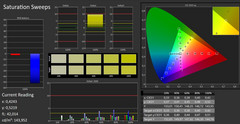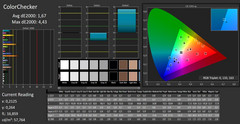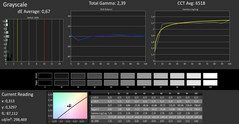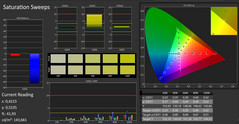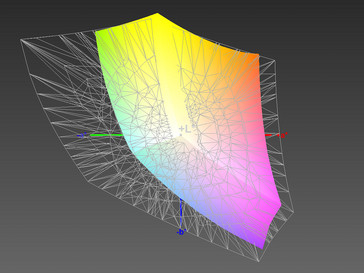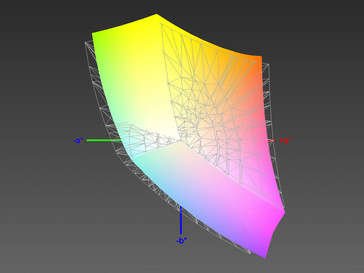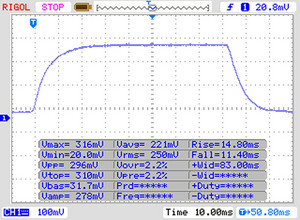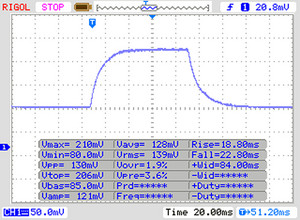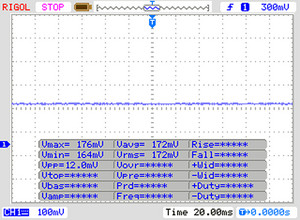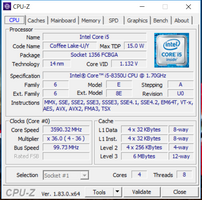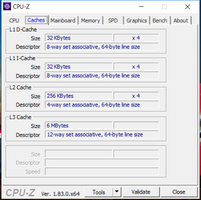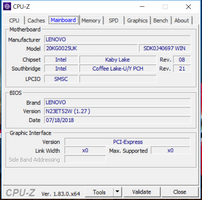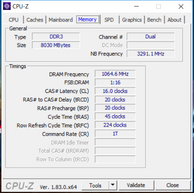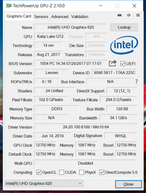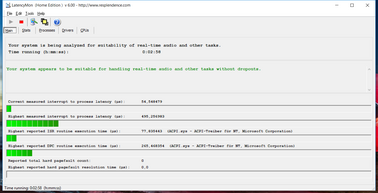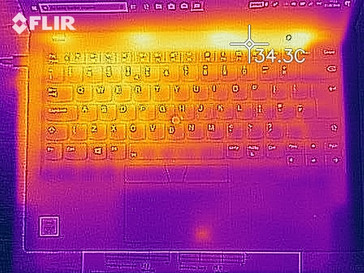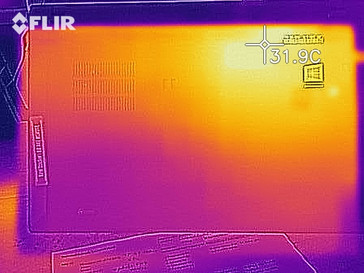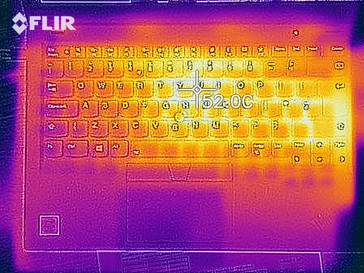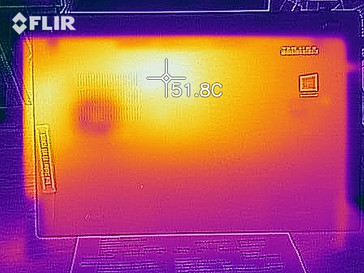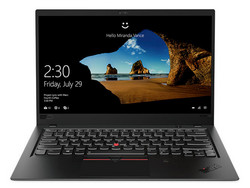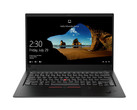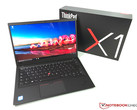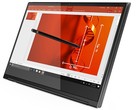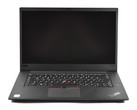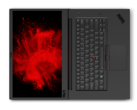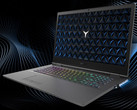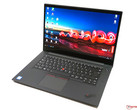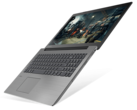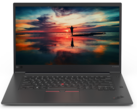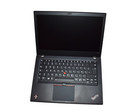Lenovo ThinkPad X1 Carbon G6 2018 (i5-8350U, Full-HD Touch, 256GB) Laptop Review
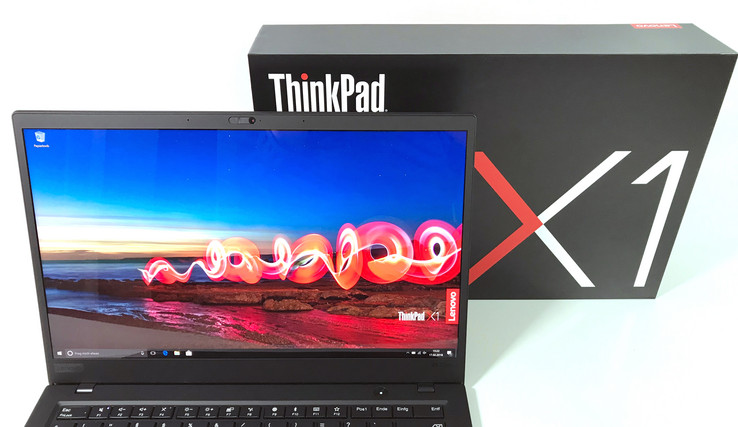
The Lenovo ThinkPad X1 Carbon G6 2018 is an expensive, lightweight and compact 14-inch business notebook. Renowned for their lightweight yet robust carbon-fiber strengthened cases and their superior input devices, the ThinkPad series is designed for professional users. Recent ThinkPad devices have scored highly in reviews not just including our own. Our Carbon G6 test device is the 20KG0025UK. As the suffix suggests, our test device is a UK variant that comes with an English keyboard layout. This specific variant is unavailable in Germany, but the equivalent configuration costs around €2,000 (~$2337). An overview of the different basic variants can be found here.
The Carbon G6 is equipped with an Intel Core i5-8350U processor that integrates Intel UHD Graphics 620, 8 GB of RAM and a 256 GB SSD. Our test device comes with a 14-inch matte IPS 1,920x1,080 display. The device also includes two Thunderbolt 3 ports, two USB Type-A ports and an HDMI port among others. The Carbon G6 is 15 mm (~0.6 in) thick and weighs 1.13 kg (~2.5 lb), which makes the device thinner and lighter than many of its competitors. All this comes in at a steep €1,749 (~$2043) at the time of writing.
We will not be covering the Carbon G6’s case, connectivity, input devices or speakers in this review as they are identical to those used in the WQHD HDR variant which we reviewed in February. Please see our Lenovo ThinkPad X1 Carbon 2018 (WQHD HDR, i7) review for our views on these areas.
We have chosen to compare the Carbon G6 against other 14-inch business notebooks that currently rank within our top ten list for office notebooks. These devices and the Carbon G6 are similarly priced too. We will also be comparing the Carbon G6 against its predecessor for the sake of completeness. Our comparison devices are the following:
Case
Connectivity
Input Devices
Touchscreen
The Carbon G6 has a ten-point multitouch matte display that recognizes inputs precisely and promptly. The matte finish has several practical benefits over typical glossy finishes including use with damp hands. Whereas damp fingers tend to stick to the surface of glossy displays, we were able to use the touchscreen on the Carbon G6 with wet hands without issue.
Display
Our test device is equipped with an AU Optronics panel that carries the model number B140HAK02.3. This 14-inch IPS display runs at a native resolution of 1,920x1,080 and has a 157 PPI pixel density. Our test device achieves an average maximum brightness of 286.7 cd/m² when measured with X-Rite i1Pro 2, which is only brighter than the Lenovo ThinkPad X1 Carbon 2017 of our comparison devices. By Contrast, the HP EliteBook 840 G5 achieved a value of 630 cd/m², which is considerably brighter than the Carbon G6. The HP EliteBook 745 G5 is brighter too, but by a smaller margin than the EliteBook 840 G5 while the Dell Latitude 7490 is only 2% brighter than our test device.
The Carbon G6 has a 91% uniformly bright display that is on par with its predecessor and is only marginally bettered by the EliteBook 840 G5. This degree of brightness uniformity means that the display looks homogenously black in a darkened room. We did notice some backlight bleeding at the bottom of the display, but this is minimal and would not be an issue in daily use.
Lenovo also offers a glossy WQHD HDR variant with or without a touchscreen, our view on which can be read in our Lenovo ThinkPad X1 Carbon 2018 (WQHD HDR, i7) review. It is also possible to configure the Carbon G6 with a non-touch 1,920x1,080 display, bringing the number of display options up to four.
| |||||||||||||||||||||||||
Brightness Distribution: 91 %
Center on Battery: 304 cd/m²
Contrast: 1490:1 (Black: 0.2 cd/m²)
ΔE ColorChecker Calman: 2.19 | ∀{0.5-29.43 Ø4.78}
calibrated: 1.67
ΔE Greyscale Calman: 1.97 | ∀{0.09-98 Ø5}
95% sRGB (Argyll 1.6.3 3D)
62% AdobeRGB 1998 (Argyll 1.6.3 3D)
69.3% AdobeRGB 1998 (Argyll 3D)
94.9% sRGB (Argyll 3D)
68.3% Display P3 (Argyll 3D)
Gamma: 2.43
CCT: 6571 K
| Lenovo ThinkPad X1 Carbon G6-20KG0025UK Lenovo LEN40A9 / AUO B140HAK02.3, , 1920x1080, 14" | HP EliteBook 840 G5-3JX61EA IVO M140NVF7 R0, , 1920x1080, 14" | Dell Latitude 7490 AUO503D (D04YD_B140HAN), , 1920x1080, 14" | HP EliteBook 745 G5 3UN74EA AUO383D, , 1920x1080, 14" | Lenovo ThinkPad X1 Carbon 2017-20HR0021GE B140HAN03_1, , 1920x1080, 14" | |
|---|---|---|---|---|---|
| Display | -10% | -1% | -9% | -9% | |
| Display P3 Coverage (%) | 68.3 | 61 -11% | 66.6 -2% | 61.3 -10% | 61.6 -10% |
| sRGB Coverage (%) | 94.9 | 87.7 -8% | 96.8 2% | 87.6 -8% | 87.6 -8% |
| AdobeRGB 1998 Coverage (%) | 69.3 | 62.1 -10% | 67.9 -2% | 62.3 -10% | 62.6 -10% |
| Response Times | 7% | -16% | 6% | -21% | |
| Response Time Grey 50% / Grey 80% * (ms) | 40 ? | 33 ? 17% | 41.6 ? -4% | 35 ? 12% | 48 ? -20% |
| Response Time Black / White * (ms) | 25 ? | 26 ? -4% | 32 ? -28% | 25 ? -0% | 30.4 ? -22% |
| PWM Frequency (Hz) | 3125 ? | ||||
| Screen | -18% | -55% | -18% | -25% | |
| Brightness middle (cd/m²) | 298 | 655 120% | 308.6 4% | 421 41% | 278 -7% |
| Brightness (cd/m²) | 287 | 630 120% | 294 2% | 398 39% | 271 -6% |
| Brightness Distribution (%) | 91 | 93 2% | 89 -2% | 86 -5% | 91 0% |
| Black Level * (cd/m²) | 0.2 | 0.56 -180% | 0.23 -15% | 0.27 -35% | 0.16 20% |
| Contrast (:1) | 1490 | 1170 -21% | 1342 -10% | 1559 5% | 1738 17% |
| Colorchecker dE 2000 * | 2.19 | 3.27 -49% | 6.07 -177% | 4.08 -86% | 4.5 -105% |
| Colorchecker dE 2000 max. * | 4.39 | 5.92 -35% | 10.58 -141% | 7.48 -70% | 8.4 -91% |
| Colorchecker dE 2000 calibrated * | 1.67 | 3.22 -93% | 1.67 -0% | ||
| Greyscale dE 2000 * | 1.97 | 2.85 -45% | 7.3 -271% | 2.92 -48% | 3.2 -62% |
| Gamma | 2.43 91% | 2.45 90% | 2.061 107% | 2.32 95% | 2.02 109% |
| CCT | 6571 99% | 6065 107% | 7269 89% | 7043 92% | 7042 92% |
| Color Space (Percent of AdobeRGB 1998) (%) | 62 | 57 -8% | 62 0% | 57 -8% | 57 -8% |
| Color Space (Percent of sRGB) (%) | 95 | 88 -7% | 97 2% | 87 -8% | 87.5 -8% |
| Total Average (Program / Settings) | -7% /
-13% | -24% /
-40% | -7% /
-13% | -18% /
-21% |
* ... smaller is better
Our test device has a 0.2 cd/m² black value that is only bettered by its predecessor. This low black value helps the Carbon G6 achieve an impressive 1,490:1 contrast ratio that is only slightly behind the EliteBook 745 G5 and the X1 Carbon 2017. The latter achieved a 1,738:1 contrast ratio during our tests, demonstrating how crucial a low black value is to a device having a good contrast ratio.
Our test device and the EliteBook 840 G5 are the only two devices in our comparison table that have acceptable factory color accuracy. Our test device is in line with the ideal DeltaE value of three by default and can be further improved with additional calibration. It is worth bearing in mind that the human eye cannot perceive color deviations of fewer than three on the DeltaE scale. ColorChecker and grayscale values are exemplary after additional calibration; we have included the ICC color profile above our comparison table should you wish to use it.
The display is 95% sRGB accurate by default and has a color temperature of 6,571 K. While the latter is close to the ideal 6,500 K value, the degree of color accuracy prevents the Carbon G6 from being recommended for professional image editing. The Carbon G6 would be fine for casual image editing, but we only recommend devices for professional image editing when they are much closer to 100% sRGB accurate.
We used the Carbon G6 outside to test its usability outdoors. Unfortunately, we were only able to test the device on overcast days and cannot say conclusively how easy it is to read the Carbon G6’s display on sunny days.
We took the first photo with the display angled at the bright, albeit overcast, sky. The matte finish diffuses reflections well and the screen content is still entirely visible. Experience suggests that the matte finish will not prevent reflections when using the device in direct sunlight. Hence, we would recommend using the Carbon G6 in a shady spot as we did in the second photo. These are ideal conditions for using the device outdoors as you will experience no distracting reflections even in sunny weather. It is worth noting that this would not be necessary when using the device on cloudier days.
Display Response Times
| ↔ Response Time Black to White | ||
|---|---|---|
| 25 ms ... rise ↗ and fall ↘ combined | ↗ 14 ms rise | |
| ↘ 11 ms fall | ||
| The screen shows relatively slow response rates in our tests and may be too slow for gamers. In comparison, all tested devices range from 0.1 (minimum) to 240 (maximum) ms. » 58 % of all devices are better. This means that the measured response time is worse than the average of all tested devices (20.2 ms). | ||
| ↔ Response Time 50% Grey to 80% Grey | ||
| 40 ms ... rise ↗ and fall ↘ combined | ↗ 18 ms rise | |
| ↘ 22 ms fall | ||
| The screen shows slow response rates in our tests and will be unsatisfactory for gamers. In comparison, all tested devices range from 0.165 (minimum) to 636 (maximum) ms. » 60 % of all devices are better. This means that the measured response time is worse than the average of all tested devices (31.6 ms). | ||
Screen Flickering / PWM (Pulse-Width Modulation)
| Screen flickering / PWM not detected | |||
In comparison: 53 % of all tested devices do not use PWM to dim the display. If PWM was detected, an average of 8111 (minimum: 5 - maximum: 343500) Hz was measured. | |||
Our test device has strong viewing angles as is typical for devices with IPS panels. There are minimal brightness and contrast loss at angles acuter than 45 °, which is better than most IPS displays that we have tested. These distortions are most noticeable when looking down on the device with the display at an acute angle; this should not be an issue in daily use.
Performance
The Carbon G6 is powerful enough for not only office tasks but also more demanding programs thanks to its cutting-edge quad-core processor. The device will struggle to run memory-hungry programs because of its 8 GB of RAM. The high-speed RAM helps in this regard, but the device would benefit from a higher 4K read value. We will be discussing this further in the Storage Devices section.
Lenovo offers numerous configuration options including faster CPUs, larger SSDs and up to 16 GB of RAM. This would help reduce any potential bottlenecks when running intensive programs; these factory upgrades naturally increase the device’s overall price.
Processor
Our test device is equipped with an Intel Core i5-8350U quad-core processor. Intel announced this CPU in August 2017 and created it based on their Kaby Lake Refresh architecture. The CPU has a 1.7 GHz base clock speed that can increase up to 3.6 GHz thanks to Intel Turbo Boost technology. Likewise, the Core i5-8350U supports Intel Hyper-Threading which allows the CPU to run up to eight threads, or processes, simultaneously.
The Core i5-8350U has a 15-W thermal design power (TDP), which makes it suitable for compact sub-notebooks and ultrabooks. The Core i5-8350U integrates a DDR4 memory controller, Intel UHD Graphics 620 and provides around 40% better performance than its dual-core predecessor, the Core i5-7300U.
The Core i5-8350U initially scored 63% higher in a Cinebench R15 multi-core benchmark than the average of Core i5-8350U powered devices that we have currently tested. This advantage drops to 2% in the single core benchmark. The Carbon G6 is 2% shy of the Latitude 7490 in single-core Cinebench R15 too despite being 11% faster in the multi-core benchmark. Last year’s X1 Carbon is well beaten in both tests, while the Ryzen 7 2700U is comparable to the performance achieved by our test device.
While our test device initially scores an impressive 630 points in the multi-core Cinebench R15 benchmark this drops dramatically to 455 points by the third loop of the benchmark, representing a 28% performance drop. Scores vary between 456 and 490 thereafter, but mostly in the 460 range. This performance drop reflects a reduction in TDP as clock speeds remained consistent throughout the benchmark loop.
System Performance
It is worth bearing in mind that PCMark 8 works poorly on current systems and it should now be considered a bad judge of system performance. Vastly different hardware often achieve similar scores as reflected in our comparison table. Our test device and its predecessor's scores are practically identical in PCMark 8 but separated by 17% in PCMark 10. The EliteBook 840 G5 edges both versions of PCMark, while the Ryzen 7 2700U powered EliteBook 745 G5 finishes bottom in both benchmarks.
The Carbon G6 performs well in daily use. Programs launch quickly, and we experienced no multitasking related issues. Our test device took slightly longer to boot than comparable devices, but this is only a minor and relatively subjective gripe.
| PCMark 8 Home Score Accelerated v2 | 3690 points | |
| PCMark 8 Work Score Accelerated v2 | 4600 points | |
| PCMark 10 Score | 3764 points | |
Help | ||
Storage Devices
The Carbon G6 is equipped with a PCIe 256 GB SSD that is mostly on par with those used in our comparison devices. Our test device has fast sequential read speeds that are only beaten by the SSD used in the EliteBook 840 G5. However, we expect better 4K write speeds as this is particularly important for office notebooks; 4K read speed represents the speed at which a device can read small blocks of data. Our test device is resoundingly beaten by the EliteBook 840 G5 in other areas too, which culminates in the latter achieving an overall 45% higher CrystalDiskMark 3.0 score than the Carbon G6.
| Lenovo ThinkPad X1 Carbon G6-20KG0025UK Lenovo LENSE20256GMSP34MEAT2TA | HP EliteBook 840 G5-3JX61EA Toshiba KXG50ZNV1T02 | Dell Latitude 7490 Toshiba KSG60ZMV256G | HP EliteBook 745 G5 3UN74EA Toshiba XG5 KXG50ZNV256G | Lenovo ThinkPad X1 Carbon 2017-20HR0021GE Toshiba THNSF5256GPUK | Average Lenovo LENSE20256GMSP34MEAT2TA | |
|---|---|---|---|---|---|---|
| CrystalDiskMark 3.0 | 45% | -11% | 17% | -2% | ||
| Read Seq (MB/s) | 1880 | 2087 11% | 1549 -18% | 1277 -32% | 1703 ? -9% | |
| Write Seq (MB/s) | 479 | 907 89% | 269.7 -44% | 648 35% | 642 ? 34% | |
| Read 512 (MB/s) | 1227 | 993 -19% | 823 -33% | 972 -21% | 1217 ? -1% | |
| Write 512 (MB/s) | 243.3 | 623 156% | 298.1 23% | 311 28% | 272 ? 12% | |
| Read 4k (MB/s) | 34.87 | 32.84 -6% | 24.9 -29% | 34.63 -1% | 23.9 ? -31% | |
| Write 4k (MB/s) | 94.1 | 110.1 17% | 97.1 3% | 128.5 37% | 73.3 ? -22% | |
| Read 4k QD32 (MB/s) | 306.1 | 312.1 2% | 310.6 1% | 477.3 56% | 330 ? 8% | |
| Write 4k QD32 (MB/s) | 184.7 | 391.5 112% | 208.4 13% | 241.2 31% | 172 ? -7% |
Graphics Card
Intel UHD Graphics 620 handles graphics. The UHD Graphics 620 is essentially a repackaged Intel HD Graphics 620 for Kaby Lake Refresh chips. The UHD Graphics 620 shares its TDP and memory with the Core i5-8350U, which means that the GPU is best suited for 2D tasks and simple games. Integrated graphics benefit greatly from a system running dual-channel RAM, which our test device does despite being just LPDDR3 RAM. Please see our GPU benchmark page for more information on the Intel UHD Graphics 620 and its competitors.
The performance of an Intel UHD Graphics 620 GPU correlates with CPU performance. This means that the Carbon G6 performs better in GPU benchmarks than other similarly powered devices. Our test device finishes closely behind the Core i7-8550U powered EliteBook 840 G5 in these benchmarks and is way off the AMD Vega 10 graphics that powers the EliteBook 745 G5. The new Ryzen mobile APUs typically have much better graphics performance than their Intel counterparts, so this is an expected result.
Our test device scores slightly lower in a 3DMark 11 benchmark on battery power than it does on mains power.
| 3DMark 11 Performance | 2065 points | |
| 3DMark Cloud Gate Standard Score | 9353 points | |
| 3DMark Fire Strike Score | 1141 points | |
Help | ||
Gaming Performance
While the Intel UHD Graphics 620 runs well on our test device, it is just an integrated graphics solution and is not powerful enough for serious gaming. Games such as “Rise of the Tomb Raider” can be comfortably played in 720p at lowest graphics settings. Likewise, simpler 3D games such as “Diablo III”, “Farming Simulator 17” and “StarCraft II” can be played at between 1,366x768 and 1,920x1,080 with the game set to medium to high graphics.
| Rainbow Six Siege | |
| 1024x768 Low Preset AA:T AF:Linear | |
| Lenovo ThinkPad X1 Carbon G6-20KG0025UK | |
| Average Intel UHD Graphics 620 (28.2 - 48.4, n=5) | |
| 1366x768 Medium Preset AA:T AF:2x | |
| Lenovo ThinkPad X1 Carbon G6-20KG0025UK | |
| Average Intel UHD Graphics 620 (16.1 - 29.4, n=5) | |
| Rise of the Tomb Raider - 1024x768 Lowest Preset | |
| HP EliteBook 745 G5 3UN74EA | |
| Lenovo ThinkPad X1 Carbon G6-20KG0025UK | |
| Average Intel UHD Graphics 620 (10.4 - 110.7, n=82) | |
| Dell Latitude 7490 | |
| Lenovo ThinkPad X1 Carbon 2017-20HR0021GE | |
| Farming Simulator 17 | |
| 1280x720 Low Preset | |
| Lenovo ThinkPad X1 Carbon G6-20KG0025UK | |
| Average Intel UHD Graphics 620 (19 - 95.9, n=8) | |
| 1366x768 Medium Preset | |
| Lenovo ThinkPad X1 Carbon G6-20KG0025UK | |
| Average Intel UHD Graphics 620 (8 - 67.9, n=12) | |
| 1920x1080 High Preset AA:2xMS AF:2x | |
| Average Intel UHD Graphics 620 (18.8 - 26.2, n=11) | |
| Lenovo ThinkPad X1 Carbon G6-20KG0025UK | |
| 1920x1080 Very High Preset AA:4xMS AF:4x | |
| Lenovo ThinkPad X1 Carbon G6-20KG0025UK | |
| Average Intel UHD Graphics 620 (10 - 13, n=4) | |
| low | med. | high | ultra | |
|---|---|---|---|---|
| Rainbow Six Siege (2015) | 48.4 | 28.8 | ||
| Rise of the Tomb Raider (2016) | 23.9 | 12.2 | ||
| Farming Simulator 17 (2016) | 95.2 | 67.9 | 22.3 | 12.3 |
Emissions
Fan Noise
This section is rather short compared with our ThinkPad X1 Carbon 2018 (WQHD HDR, i7) review. Our test device is usually silent at idle, but sometimes the fan reaches up to 30.25 dB(A). The fan is whisper quiet under full load too and only reaches a maximum of 31.3 dB(A). The Carbon G6 is so quiet under load that we could only hear the fan in a quiet room when next to the device. Overall, the Carbon G6 is one of the quietest, if not the quietest, devices that this reviewer has currently tested.
Noise level
| Idle |
| 30.25 / 30.25 / 30.25 dB(A) |
| Load |
| 31.3 / 31.3 dB(A) |
 | ||
30 dB silent 40 dB(A) audible 50 dB(A) loud |
||
min: | ||
Temperature
Surface temperatures are relatively cool too. The device reaches a maximum of 28 °C (~82 °F) at idle while the palm rest averages around 24 °C (~75 °F). Surface temperatures typically rise under continuous load, but these only average around 32.5 °C (~90.5 °F). Parts of our test device reach 40 °C (~104 °F) but this is only in three out of eighteen segments that we divide devices into. While not particularly hot, the peak of 41.6 °C (~107 °F) on the underside of the device next to the display hinge could feel uncomfortable to some people when using the device on your lap.
We also stress tested our test device with a combined FurMark and Prime95 stress test. The CPU drops to 1.1 GHz after just a few minutes of this combined stress test while the CPU core temperature reaches a maximum of 82 °C (~180 °F). Our test device stuck at this clock speed throughout this combined stress test despite the core temperature averaging at just 71 °C (~160 °F). This behaviour highlights that Lenovo has prioritized quiet and cool operation rather than high performance under continuous load. This seems logical in a practical sense as the device is intended to be used in an office environment and not continually stress tested.
(±) The maximum temperature on the upper side is 40.7 °C / 105 F, compared to the average of 34.3 °C / 94 F, ranging from 21.2 to 62.5 °C for the class Office.
(±) The bottom heats up to a maximum of 41.6 °C / 107 F, compared to the average of 36.8 °C / 98 F
(+) In idle usage, the average temperature for the upper side is 25.2 °C / 77 F, compared to the device average of 29.5 °C / 85 F.
(+) The palmrests and touchpad are cooler than skin temperature with a maximum of 27.4 °C / 81.3 F and are therefore cool to the touch.
(±) The average temperature of the palmrest area of similar devices was 27.6 °C / 81.7 F (+0.2 °C / 0.4 F).
Lenovo ThinkPad X1 Carbon G6-20KG0025UK audio analysis
(-) | not very loud speakers (64.3 dB)
Bass 100 - 315 Hz
(-) | nearly no bass - on average 24.7% lower than median
(±) | linearity of bass is average (8.5% delta to prev. frequency)
Mids 400 - 2000 Hz
(+) | balanced mids - only 4.7% away from median
(±) | linearity of mids is average (9.9% delta to prev. frequency)
Highs 2 - 16 kHz
(+) | balanced highs - only 4.9% away from median
(±) | linearity of highs is average (8.5% delta to prev. frequency)
Overall 100 - 16.000 Hz
(±) | linearity of overall sound is average (29.6% difference to median)
Compared to same class
» 90% of all tested devices in this class were better, 3% similar, 7% worse
» The best had a delta of 7%, average was 21%, worst was 53%
Compared to all devices tested
» 87% of all tested devices were better, 3% similar, 10% worse
» The best had a delta of 4%, average was 24%, worst was 134%
HP EliteBook 840 G5-3JX61EA audio analysis
(±) | speaker loudness is average but good (75 dB)
Bass 100 - 315 Hz
(-) | nearly no bass - on average 31.2% lower than median
(±) | linearity of bass is average (11.3% delta to prev. frequency)
Mids 400 - 2000 Hz
(+) | balanced mids - only 1.7% away from median
(+) | mids are linear (6.9% delta to prev. frequency)
Highs 2 - 16 kHz
(+) | balanced highs - only 3.5% away from median
(+) | highs are linear (2.8% delta to prev. frequency)
Overall 100 - 16.000 Hz
(±) | linearity of overall sound is average (20.5% difference to median)
Compared to same class
» 44% of all tested devices in this class were better, 10% similar, 46% worse
» The best had a delta of 7%, average was 21%, worst was 53%
Compared to all devices tested
» 53% of all tested devices were better, 8% similar, 39% worse
» The best had a delta of 4%, average was 24%, worst was 134%
Dell Latitude 7490 audio analysis
(±) | speaker loudness is average but good (77.3 dB)
Bass 100 - 315 Hz
(±) | reduced bass - on average 13.6% lower than median
(±) | linearity of bass is average (10.5% delta to prev. frequency)
Mids 400 - 2000 Hz
(+) | balanced mids - only 3.9% away from median
(±) | linearity of mids is average (7.3% delta to prev. frequency)
Highs 2 - 16 kHz
(+) | balanced highs - only 3.4% away from median
(±) | linearity of highs is average (8.8% delta to prev. frequency)
Overall 100 - 16.000 Hz
(±) | linearity of overall sound is average (18.8% difference to median)
Compared to same class
» 33% of all tested devices in this class were better, 7% similar, 60% worse
» The best had a delta of 7%, average was 21%, worst was 53%
Compared to all devices tested
» 42% of all tested devices were better, 8% similar, 50% worse
» The best had a delta of 4%, average was 24%, worst was 134%
Power Management
Power Consumption
Our test device consumes between 3 and 19% more power in the three idle states than its predecessor, which is probably because of the Core i5-8350U’s two additional cores. However, the Latitude 7490 is considerably more efficient at idle despite having the same processor as our test device. By contrast, our test device is generally more efficient than both EliteBooks at idle.
We would expect the EliteBook 745 G5 to have the highest power consumption under load, thanks to its Ryzen Mobile APU. While the Ryzen 7 2700U consumes significantly more than the Core i5-8350U, its consumption under load is on par with the Core i5 7200U.
Our test is the most economical device under load and only consumes a maximum of 28.2 W. This is over 10 W less than the Latitude 7490 and just represents the degree to which the Carbon G6 throttles rather than any inherent additional efficiency under load. Despite its relatively low consumption under load, the Carbon G6 is not a particularly frugal device.
| Off / Standby | |
| Idle | |
| Load |
|
Key:
min: | |
| Lenovo ThinkPad X1 Carbon G6-20KG0025UK i5-8350U, UHD Graphics 620, Lenovo LENSE20256GMSP34MEAT2TA, IPS, 1920x1080, 14" | HP EliteBook 840 G5-3JX61EA i5-8550U, UHD Graphics 620, Toshiba KXG50ZNV1T02, IPS, 1920x1080, 14" | Dell Latitude 7490 i5-8350U, UHD Graphics 620, Toshiba KSG60ZMV256G, IPS, 1920x1080, 14" | HP EliteBook 745 G5 3UN74EA R7 2700U, Vega 10, Toshiba XG5 KXG50ZNV256G, IPS LED, 1920x1080, 14" | Lenovo ThinkPad X1 Carbon 2017-20HR0021GE i5-7200U, HD Graphics 620, Toshiba THNSF5256GPUK, IPS, 1920x1080, 14" | Average Intel UHD Graphics 620 | Average of class Office | |
|---|---|---|---|---|---|---|---|
| Power Consumption | -13% | 11% | -19% | -8% | -12% | -34% | |
| Idle Minimum * (Watt) | 4.7 | 3.8 19% | 2 57% | 4.9 -4% | 3.8 19% | 3.81 ? 19% | 4.52 ? 4% |
| Idle Average * (Watt) | 7.3 | 8.3 -14% | 4.7 36% | 8.1 -11% | 7.1 3% | 6.94 ? 5% | 7.5 ? -3% |
| Idle Maximum * (Watt) | 9.4 | 10.7 -14% | 5.7 39% | 10.6 -13% | 8.3 12% | 8.75 ? 7% | 8.9 ? 5% |
| Load Average * (Watt) | 28 | 35.5 -27% | 38.4 -37% | 32.2 -15% | 34.2 -22% | 35 ? -25% | 42.3 ? -51% |
| Load Maximum * (Watt) | 28.2 | 37 -31% | 38.9 -38% | 42.3 -50% | 43.3 -54% | 47.5 ? -68% | 63.6 ? -126% |
* ... smaller is better
Battery Life
The Carbon G6 has a 57 Wh battery that is comparable to those of our comparison devices. Our Wi-Fi battery life test is the best comparison between the Carbon G6 and our comparison devices as we lack a complete data set for both the EliteBook 840 G5 and the Latitude 7490.
We conduct our Wi-Fi battery life test by running a script that simulates the load required to render websites in forty-second intervals. We also set the display brightness to 150 cd/m². Our test device lasted ten-hours and twenty-one minutes during this test, which is around thirty-minutes longer than our best comparison devices. By contrast, the HP EliteBook 745 G5 lasted just six-hours and thirty-four minutes in this battery life test; the device does have a 10 Wh smaller battery than the Carbon G6 though.
Credit goes to the Carbon G6’s idle performance too. It trounces our comparison devices for which we have data and is seventh on our database of 14-inch office notebooks that we have currently tested. The devices that are ranked higher than the Carbon G6 have up to 96 Wh batteries, so kudos to Lenovo for their work in this regard.
| Lenovo ThinkPad X1 Carbon G6-20KG0025UK i5-8350U, UHD Graphics 620, 57 Wh | HP EliteBook 840 G5-3JX61EA i5-8550U, UHD Graphics 620, 50 Wh | Dell Latitude 7490 i5-8350U, UHD Graphics 620, 60 Wh | HP EliteBook 745 G5 3UN74EA R7 2700U, Vega 10, 50 Wh | Lenovo ThinkPad X1 Carbon 2017-20HR0021GE i5-7200U, HD Graphics 620, 57 Wh | Average of class Office | |
|---|---|---|---|---|---|---|
| Battery runtime | -29% | -12% | -36% | -16% | 11% | |
| Reader / Idle (h) | 24.5 | 10.7 -56% | 13.7 -44% | 22.3 ? -9% | ||
| H.264 (h) | 11 | 7.1 -35% | 9.6 -13% | 14.9 ? 35% | ||
| WiFi v1.3 (h) | 10.4 | 7.4 -29% | 9.1 -12% | 6.6 -37% | 9.1 -12% | 12.6 ? 21% |
| Load (h) | 1.9 | 1.6 -16% | 2 5% | 1.849 ? -3% |
Verdict
Pros
Cons
The Lenovo ThinkPad X1 Carbon G6 2018 is an excellent business notebook that is deserving of our 92% rating. Its only downside is its exorbitant price. We still wholeheartedly recommend the Carbon G6 though, as it excelled in practically every test to which we subjected it.
The Carbon G6 is equipped with premium hardware. The device has an impressive display, start-of-the-art I/O, excellent battery life and three-year manufacturer’s warranty. The Carbon G6 truly represents the best of what Lenovo currently offers.
There are advantages of choosing a 1080p panel over the WQHD HDR option too. The 1080p panel has a matte finish compared to the HDR’s glossy finish which is useful when using the device outdoors. Equally, having a lower resolution display will help extend battery life and allows the device to run cooler as it is using fewer resources to power the display. We would even recommend the 1080p non-touch panel for the same reasons. Moreover, a WQHD resolution is not essential for office work.
The choice of a Core i5-8350U processor over a Core i7 version is also a wise move as the former often outperforms the latter, while helping to keep the device cool and extending battery life too.
Lenovo ThinkPad X1 Carbon G6-20KG0025UK
- 10/03/2019 v7 (old)
Sven Kloevekorn




